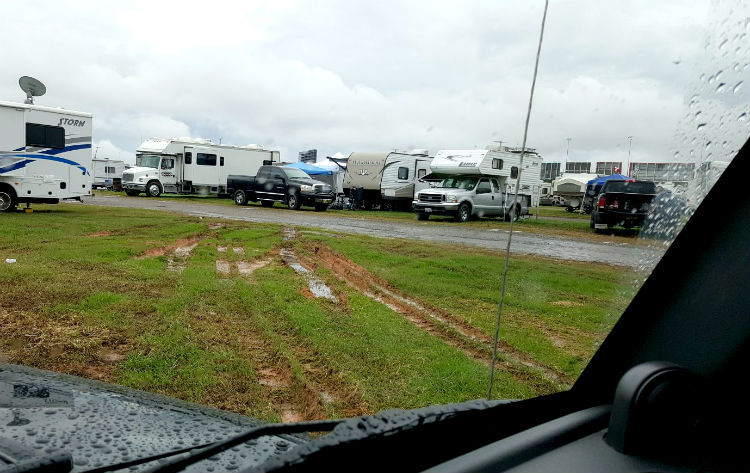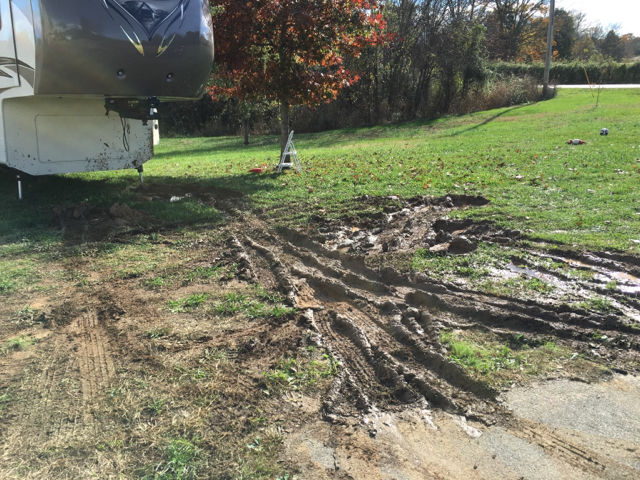Getting your RV stuck on a muddy road or campground can turn a good a day into a frustrating one. The best thing is to avoid this situation altogether.
But, if you do find your tires several inches in the earth, a little bit of knowledge and equipment may make the difference between a delay and a major tow bill.

Always survey a wet, muddy ground at an RV park before proceeding. Photo by G Shaw, iRV2.com member.
Quick tips to avoid getting your RV stuck:
- If you are unsure of the surface you will be driving on, get out and walk the road or campsite first. Is the earth firm enough to support the weight of your RV? Many RVers will probe the ground with a stick to determine firmness.
- Get out and check for adequate traction when driving on slick surfaces like snow, ice, and mud.
- Also, when the conditions are really bad, be very cautious about turning around. If the roadbed is questionable, the shoulders are likely to be worse and might give way under the weight of an RV. It’s best to back up to an area that seems safe to turn around.

Deflating your tires is also a good idea as this allows more surface of the tire tread on the ground, which provides more traction. Photo by guy.lawless iRV2.com
Avoid expensive tows
If you can’t avoid getting your RV stuck, here are several tips and tricks that will get you moving again.
- If your tires spin relentlessly in soft, dry sand, pour a few gallons of water in front of your RV’s path helps compact the sand. This makes it easier to continue driving. Further, learning what you need to know about RVing on a beach is wise if you have plans for this type of camping.
- Carry tire chains for the drive wheels. Most associate tire chains as a traction device for use on snow. But, chains can get you going again when clay roads are slick from rainwater.
- Also, get something solid under the tires for traction. The leveling blocks you carry to level your RV may be just enough to free your rig. But, if you find yourself in these situations often, consider purchasing traction products.
By following these tips you can avoid the need to call a tow truck—because this is one adventure in RVing nobody wants to experience.

“Deflating your tires is also a good idea as this allows more surface of the tire tread on the ground, which provides more traction.”
Yes and no… you don’t completely deflate the tires, you just reduce the pressure. Reducing it too much, or driving at any significant speed without properly reinflating them, will destroy the tires. Why introduce the idea of deflation without doing it properly? At least use the phrase “Reduce the pressure in your tires” instead of “Deflating your tires”.
Brian,
The original draft read, “By deflating your tires a bit ….”.
Not sure what happened after I posted it. Dave
Yeah, that would have been fine. Someone probably got carried away with caption length, and should have checked with the author that the change didn’t ruin the meaning… which it did! Thanks for the response, Dave.
A trick I learned from the H1 Hummer factory reps… They would put the Hummer in a ravine so the left front tire was on one valley and the opposite (right rear) was on the other valley. The other two tires were suspended in mid-air. Not something I would do with only a two-wheel drive vehicle but it proved its point.
Anyway, as we stepped on the gas, the two airborne tires would spin but we would not move. So the reps taught us to ride the brake, thus sending drivetrain power to the wheels on the ground. Worked every time. Also a great tip when on a slippery boat ramp. I might have got some attention while backing down the ramp but it was overcome when I was the only one (without 4×4) that did not spin the tires pulling out my boat with my old F100..
Thanks for the good advice Frank.
That works well in a HMMWV (Humvee) or Hummer H1 because it has Torsen differentials – they can provide much more torque to the slower-turning output (the tire on the ground), but there needs to be some resistance on the faster-turning output (the tire in the air) – the brakes provide the same resistance to both wheels on the axle. It won’t work as well with other limited-slip differentials, and poorly if at all with open differentials. Motorhomes don’t usually come with Torsens… unfortunately for those getting in trouble with their RVs.
I’m surprised there’s no mention of probably the most critical link in the equation – tires. If you’re going off paved roads with your pickup you need an aggressive All Terrain tire. By aggressive I mean a tire that will dig down to more solid ground as well as also provide traction along the sidewalls. The key is to keep moving forward so not to break traction. Also by having an open tread design, the tires can self-clean as they spin. If you’re driving on highway tires, once the treads are filled up with packed mud, you’re driving on worthless balloons.
On the Oregon coast we “reduce our tire pressue” and drive our truck and 24″ Toyhauler out into the Dunes fully loaded. We carry an air compressor so when we leave, we pull back onto solid ground and air back up. Thousands of people do this here. It works great.
Yes, reducing air pressure is a great way to gain additional traction on soft ground. Thanks for sharing
I have to disagree with Brian.
The brake technique will work with a full open differential.
My Rav 4, and Tacoma, claimed they had Auto LSD. If fact, all they did was apply the brake to the spinning wheel once there was a large enough speed difference between the tires on that axle.
Also, why do you think farm tractors have the option to apply brakes to only one wheel?
Tips, if you have a 4×4 with open diffs, or a front wheel drive car, use the main brake.
If you have a rear wheel drive car, use the e-brake instead. This prevents your front wheels from acting like skis.
I have used the brake method two ways:
Apply full brake, high idle the engine, and slowly release the brake, until the vehicle starts to move.
The other is to keep applying brakes until the wheels stop spinning. The problem with this method is that you could make the hole worse until you find the braking power needed.
Also, if you are pulling a trailer, and using your main brakes, disconnect the trailer electrical cord..
Otherwise, the trailer will act like a sled.
Also, taking weight off the drive wheels might help. (This worked for me when my car was stuck in sand.)
The Toyota systems only brake the spinning wheel, as you said.
Farm tractors often have individual wheel brakes to enable tighter turns… and obviously, using them means braking only one wheel.
Pushing the pedal in the middle applies the brakes at all wheels – that’s very different.
The only time you should need to use the brake method, is with an open Diff.
Still, Brian says this is the only time it will not work?
Why do you think that? An open diff applies the same torque to both wheels, Reducing the torque at each of them equally with the braking system doesn’t help.
If you have a proportional trailer brake controller, the trailer brakes will only activate if you are decelerating (or if you have a “boost” function turned on), so they won’t drag.
If you have a non-proportional time-based brake controller, throw it out (responsibly… so take to an electronic waste collection facility) and spend the hundred bucks for a proper controller. Until you do that… yes, it will cause the trailer brakes to drag.
If you can, camp up on a hill with good drainage and pointing slightly downhill or so your tow vehicle can pull in a downhill direction. Also look for a gravelly not grassy spot. Learned that at Watkins Glen International a few years ago.
Try typing the following phrase in you tube:
Winching my car with wheels
a cordial greeting
Rear wheels with slotted rims, slide a 2×4 board thru and tie it off to the wheel with it extended out of the wheel. As you drive off the board will catch traction . If in a really muddy situation use more than 1 board.
There is a lot of partial or misinformation here…..key to not getting stuck is understanding how your tire bears on the ground. If you can be sure that the ground can support the pressure you have to place on it, you won’t get stuck. The average person produces a ground pressure of 16PSI. Your RV exerts whatever pressure it has in the tires. Use good judgment by checking the ground before you drive across it. If you sink in significantly while walking, don’t drive on it. If you still intend to drive on it, lower your tire pressure accordingly. You can lower your tire pressure to as low as 20PSI safely as long as you keep speed less than 10MPH. The biggest risk is turning sharply which can force the tire off the bead and deflate it completely. In an emergency, you can deflate as low as 12PSI. The tread of a tire has nothing to do with how much ground pressure it will apply. Many vehicles are equipped with optional ‘traction control’ which uses the ABS system to monitor differential wheel speed and applies brakes to the individual wheels that are turning faster (thereby redirecting torque to the non-spinning wheels). This system is very effective but usually must be manually enabled.
Traction control is normally active by default – the driver has to manually disable it, and in most cases it will reset so it would need to be disabled each time the vehicle is started… but all of that is in the owner’s manual. When it takes action, there is usually an indication on the instrument panel, as explained in the owner’s manual.
My advice comes from 34 years experience making my living driving large trucks off road. Traction control shut it off once you’re moving. Leaving it on will shut your down momentum, which you need to keep when heavy and towing. Avoid sharp turns if u can it can cause steer tires to dig in, and tandem axels to slide and dig in also. If u do get stuck trying to get unstuck could be the worst thing to do. Bury your rig up to the axles and you’re done. You’ll be surprised at how easily a small vehicle or winch or come along can get you moving if you stopped trying to get out before you bury it.